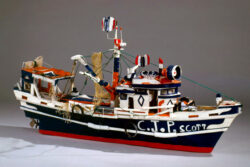J. P. Scott
James "J. P." Scott was a Louisiana folk artist who spent much of his life working on construction sites and fishing boats in the bayous around New Orleans. He is best known for his elaborate boats made from found objects, including Mardi Gras beads, toys, and seashells.

Courtesy of New Orleans Museum of Art
Shrimp Boat. Scott, James (Artist)
James “J. P.” Scott of Lafitte, Louisiana, built model boats— decorative replicas of the vessels that are integral to working life and recreation in the coastal communities of South Louisiana. From his home where he looked out upon Bayou Barataria, Scott was inspired to construct small-scale duplicates of the variety boats that lined the waterway. His model boats are usually four to five feet in length, constructed of crude materials, painted in multiple colors, and detailed with a vast array of found objects.
Born in Orina, Louisiana, on November 16, 1922, Scott was the son of a fisherman. He attended Orina Church School until the sixth grade, when he dropped out to get a job. Following his father’s example, Scott went to work on a number of boats out of Empire, Louisiana, another fishing community.
As a young man Scott also unloaded trucks at the port of New Orleans and later worked at various construction jobs in the city. He married Evelina Jackson in 1946, and they had three daughters and one son. The couple separated in 1962 but never divorced when Scott inherited a house in Lafitte and Evelina refused to move.
After relocating to Lafitte, Scott did a little work on commercial fishing boats, hunted muskrats, and performed odd jobs. From 1975 to 1984, he worked at Lafitte Canning Company as a maintenance man and a machine operator. In his spare time Scott began building model boats. Scott obtained materials for his art from garbage dumps or along the bayou, where fishermen tossed unwanted scraps of net and where pieces of driftwood were his for the taking.
Scott used ordinary hand tools such as saws, metal cutters, hammers, nails, and pliers to build his boats and preferred to work without any previously drawn plans. Reflecting even the smallest characteristics of the original, each of Scott’s model boats is extremely intricate. Their appearance goes beyond that of surface detail in that most of the parts are movable and serve the same functions as their counterparts on an actual boat. The accuracy of the complex structures is evidence of the many years that Scott spent observing and admiring every nuance of their bayou prototypes.
Using letters he cut out of wood, Scott “signed” each boat with either his initials or his full name. These raised letters were painted and then attached to the side of the hull or the captain’s cabin. Scott often named his boats after family members, friends, or port towns; he sometimes gave his boats more unusual names, such as Scott Family Reunion, which commemorated a special event.
After constructing and painting each boat with leftover house paint, Scott attached numerous found objects: Mardi Gras beads, seashells, plastic objects, small trinkets, flags.
Scott was uncompromisingly stern in his refusal to allow people to rush him, especially during the finishing stages. It took him at least a month to build a boat, and once a boat was finished, Scott would set it outside on a specially decorated stand to “weather” and also to receive his careful evaluation. If he decided that it passed inspection and he was ready to let it go, he would finally sell it. However, he was known to scrap a nearly completed but unsatisfactory boat and salvage pieces for reuse in building another one. For this reason, Scott did not consider himself an artist: “I don’t think myself an artist cause if I build something and take it back down, and I know when I’m gonna get to it again, you see. Now an artist, he go on with something right all the way.”
Before collectors discovered Scott’s work, he was well known by the residents of Lafitte for his roadside armada. As he finished each boat, he put it outside in his yard, and in time he had an entire fleet to enjoy.
He occasionally built replicas of churches, planes, and houses in the fishermen’s quarter, but his artistic self-fulfillment came from building his boats.
Although Scott’s work appears similar to traditional forms of folk art and craftsmanship, it is fundamentally different. Unconcerned with communal traditions, he was untrained and idiosyncratic in his choice of materials. Even though there is no “narrative” quality to his work, it became for him a significant outlet of personal expression.
Adapted with permission from Pictured in My Mind : Contemporary American Self-Taught Art from the Collection of Dr. Kurt Gitter and Alice Rae Yelen, University Press of Mississippi
